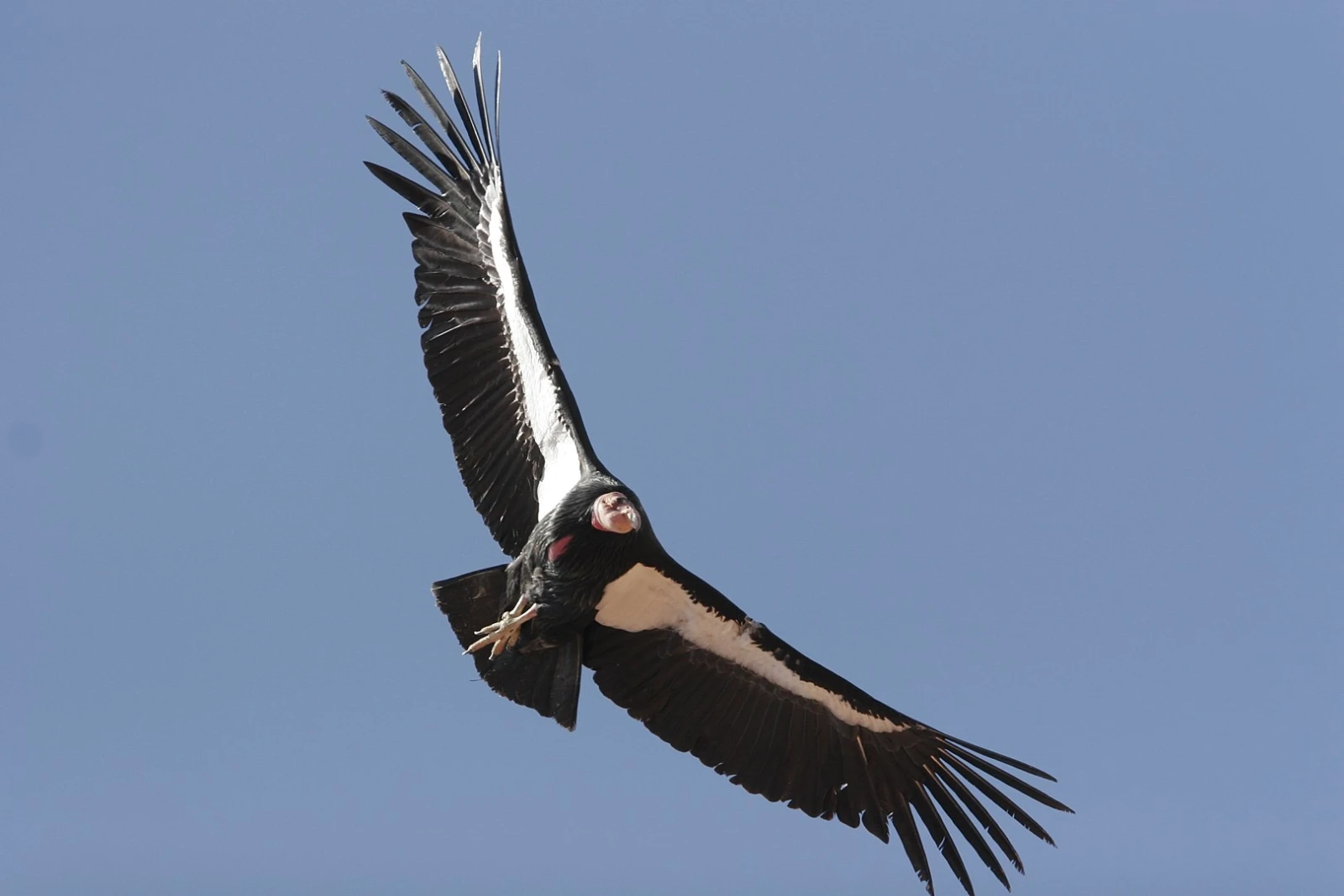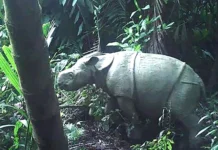The California condor (Gymnogyps californianus) is one of the most iconic and endangered birds in North America. With a population hovering around 500 individuals, this majestic species has experienced a dramatic recovery after nearly being driven to extinction in the 20th century. Known for its massive wingspan of up to 9.5 feet, the California condor is one of the largest flying birds in the world, and its remarkable story is one of resilience, hope, and conservation success.

The California Condor’s History
The California condor was once widespread across North America, from the western United States to parts of Canada and Mexico. It thrived in open habitats, including coastal regions, mountain ranges, and deserts, where it played a vital role as a scavenger. As a vulture species, the condor fed primarily on the carcasses of large mammals, such as deer, bison, and other animals.
However, by the mid-20th century, the California condor’s population had sharply declined. The species faced numerous threats, including habitat loss, poisoning, shooting, and the decline of its food sources due to human activities. By the 1980s, the population had dwindled to a critical low, with fewer than 30 individuals remaining in the wild. This prompted scientists and conservationists to take extraordinary measures to save the species from extinction.
A Controversial Decision: Captive Breeding
In 1987, a controversial decision was made to capture the remaining wild California condors in an effort to save them from extinction. All 27 known wild condors were taken into captivity and placed in breeding programs. While this decision was met with resistance by some, it was ultimately deemed necessary to prevent the species from disappearing forever.
The captive breeding program, led by the San Diego Zoo and other wildlife organizations, aimed to breed condors in controlled environments and release them back into the wild once their numbers had sufficiently increased. This initiative marked the beginning of one of the most ambitious wildlife conservation efforts in history.
The Condor Recovery Program
The recovery of the California condor has been an incredibly complex and long-term project, involving a combination of captive breeding, reintroduction, and intensive monitoring. Over the past few decades, this program has made significant strides in rebuilding the condor population and improving its chances of survival.
Captive Breeding and Reintroduction
The first successful captive breeding efforts began in the late 1980s, with condors being paired for mating and cared for in large, open-air enclosures. The goal was to ensure genetic diversity, a critical factor in maintaining a healthy population. By the mid-1990s, the first generation of condors raised in captivity was ready to be reintroduced into the wild.
The reintroduction process was carefully planned and took place in stages. In 1992, the first group of captive-bred condors was released into the wild in California’s Los Padres National Forest. This marked a pivotal moment in the species’ recovery, but the challenges of reintroducing captive-born birds into the wild were only just beginning.
Monitoring and Conservation Efforts
To ensure the success of the reintroduction efforts, biologists and wildlife experts closely monitored the released condors. Each bird was fitted with a GPS transmitter to track its movements and ensure its survival. The release sites were chosen based on the presence of suitable habitats, food sources, and minimal human disturbance. Over the years, more and more condors were released into the wild, and the population began to grow.
In addition to monitoring the condors’ movements, conservationists also took steps to protect the species from the many threats that had previously caused its decline. These efforts included educating the public about the importance of condor conservation, working with local communities to minimize human-wildlife conflict, and addressing issues such as lead poisoning, which has been a significant threat to the species.
The Threats Facing the California Condor
Despite the success of the recovery program, the California condor still faces numerous challenges in the wild. These challenges require ongoing efforts from conservationists, government agencies, and local communities to ensure the species continues to thrive.
Habitat Loss
Habitat loss remains one of the most significant threats to the California condor. As human populations grow and development expands, the condor’s natural habitats are increasingly fragmented and destroyed. Condors require large, undisturbed areas for foraging, nesting, and roosting, and habitat destruction can lead to reduced food availability and increased risk of collisions with human infrastructure, such as power lines and vehicles.
Lead Poisoning
Lead poisoning has proven to be one of the most devastating threats to the California condor’s survival. Condors, as scavengers, often feed on the carcasses of animals that have been killed by hunters using lead ammunition. When the condors ingest lead fragments from these carcasses, it can lead to poisoning, which is often fatal if not treated quickly. Lead poisoning has been responsible for the deaths of several condors in the wild, despite efforts to reduce its impact.
In response to this threat, conservationists have worked to encourage the use of non-lead ammunition by hunters and have conducted outreach campaigns to raise awareness of the issue. Additionally, condors are regularly monitored for signs of lead poisoning, and treatment is provided when necessary. However, the continued use of lead ammunition remains a critical issue in the effort to protect the species.
Human-Wildlife Conflict
Human-wildlife conflict remains another challenge for the California condor. As the birds’ population grows and their range expands, they often come into contact with human settlements and activities. Condors may be attracted to areas where food is readily available, such as farms, ranches, or even garbage dumps. While this can be beneficial for the birds in terms of food sources, it can also lead to conflicts with humans, particularly when condors are seen as a threat to livestock or crops.
To mitigate human-wildlife conflict, conservationists have worked to educate local communities about the importance of the condor and its role in the ecosystem. Measures have also been implemented to discourage condors from feeding in areas where they may come into conflict with humans.
The Current State of the Population
As of recent estimates, there are approximately 500 California condors in the wild and in captivity. This is a remarkable increase from the 27 individuals that remained in the wild just a few decades ago. However, the species remains classified as critically endangered by the International Union for Conservation of Nature (IUCN), and its future remains uncertain.
The condor’s population is still highly vulnerable to threats such as habitat loss, lead poisoning, and human-wildlife conflict. While the species has made significant strides toward recovery, continued conservation efforts are essential to ensure the California condor does not slip back toward extinction.
The Role of Public Engagement and Education
One of the key factors in the success of the California condor recovery program has been public engagement and education. Local communities, wildlife enthusiasts, and the general public have played a vital role in supporting conservation efforts, from advocating for lead-free ammunition to volunteering in monitoring and protection programs.
Educational programs aimed at raising awareness about the condor’s plight have been instrumental in building support for the species’ recovery. These programs emphasize the importance of protecting natural habitats, reducing human-wildlife conflict, and using non-toxic materials in hunting and other activities.
A Symbol of Hope
The recovery of the California condor is a testament to the power of conservation efforts and the resilience of nature. From the brink of extinction to a population of around 500 individuals, the condor’s recovery story offers hope for other endangered species facing similar threats. While much work remains to be done, the success of the California condor serves as a reminder that, with dedication, collaboration, and a commitment to protecting biodiversity, it is possible to reverse the damage caused by human activity and safeguard the future of our planet’s most vulnerable species.
As the California condor soars across the skies once more, it symbolizes the potential for conservation success and the importance of continued efforts to protect the natural world for future generations. With ongoing vigilance and support, the California condor can continue to thrive in the wild, a living testament to the power of recovery and the promise of a brighter future for endangered species everywhere.





























